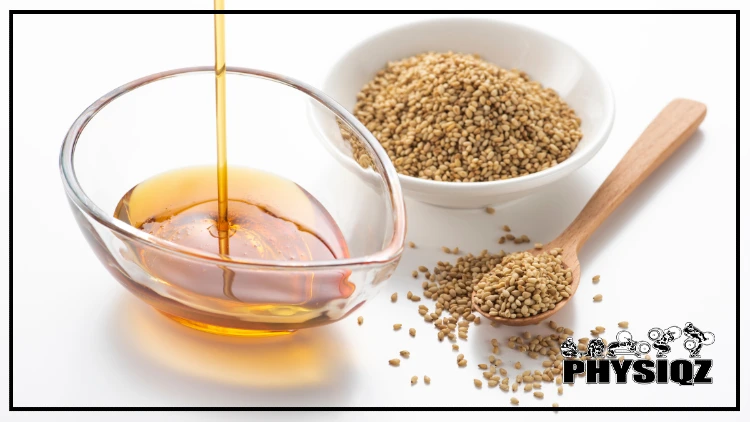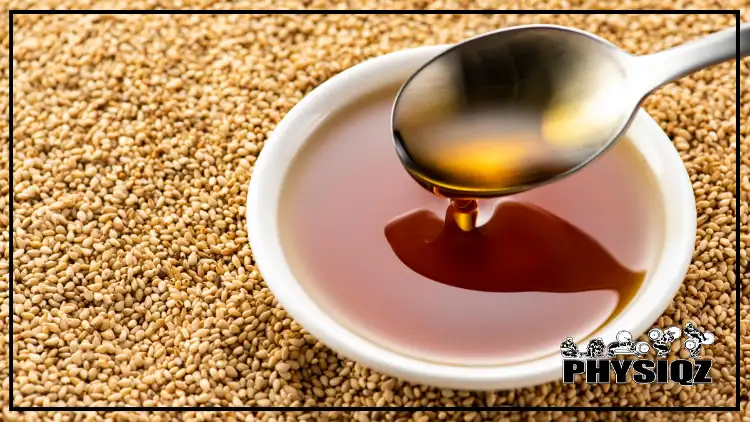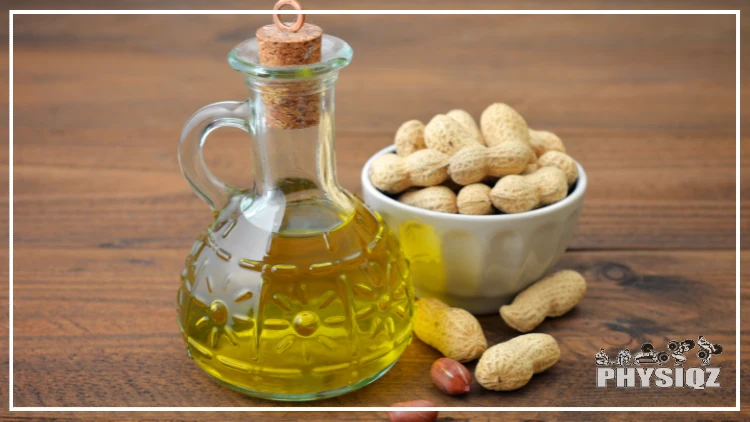
Sesame seeds and their oil, valued in East Asian cooking for both their flavor and health benefits, are often considered suitable for a keto diet.1 However, it’s also a very particular oil that many people make these culinary and dietary mistakes with – the mistake of over heating sesame oil and/or using sesame oil for the wrong applications.
Therefore, knowing how to use sesame oil and avoiding this common keto oil mistake can be sure dieters don’t make sesame oil unhealthy and can be sure the proper oil is used in order to make the most delish dish while staying in ketosis.
Sesame Oil’s Compatibility with the Keto Diet
Sesame oil is keto-friendly because the reasons that might exclude a food from the keto diet do not apply to it. Foods that are high carb aren’t keto, and low-carb foods that are otherwise unhealthy are known as dirty keto.
However, sesame oil is carb-free and unquestionably healthy in moderation.
How Many Carbs Are in Sesame Oil?
There are no carbs in sesame oil. While sesame seeds have a minor amount of carbs, the oil extraction process removes these compounds. The only thing that remains is pure, keto-friendly sesame oil.
Toasted Sesame Oil and the Keto Diet
Given that sesame oil contains zero carbs, its suitability for a keto diet should be evident. Essentially, some people consider that sesame oil is dirty keto because it has a concentration of Omega 6 fats that break down when sesame oil becomes too hot.2
Plus, there’s a misconception that Omega 6 fats are inherently unhealthy and cause inflammation. These are the mistakes people make when they decide to keep sesame oil out of their keto diet.

Source: kuppa_rock via Canva.com3
While sesame oil becomes unhealthy if burnt, that’s true of all oils. For that matter, the 350-410 degrees Fahrenheit smoke point of sesame oil is better than olive oil and coconut oil, which are popular keto oils.
Another important point is that it’s possible to increase the smoke point of sesame oil by blending it with other oils, which helps preserve its health benefits.4
As to the other reason that people believe sesame oil isn’t keto, Omega 6 aren’t the enemy they’re treated as. Practical studies have shown that in moderation and paired with Omega 3’s, Omega 6 oils may help to regulate inflammation and promote good health.5
While the science behind the health value of Omega 3 oils is well-established, the relationship between Omega 6’s and inflammation is complicated and still not fully understood by modern nutritional science.6
Either way, there’s a key wrinkle in the health value of sesame oil that many overlook. Studies have proven that Omega 6 fatty acids or not, sesame oil is anti-inflammatory.7
This is thanks to a compound called sesamin, which occurs naturally in sesame oil. Sesamin reduces inflammation to the point that studies investigate sesame as a potential treatment for inflammatory diseases.8 At this point, it’s clear that sesame oil is indeed keto-friendly.
Sesame Seed Carbs in Comparison to Sesame Oil
Sesame seeds have a trace amount of carbs, since they still have organic material besides the fat. A two tablespoon serving of sesame seeds contains less than three grams of carbs, half of which are fiber. As a result, a serving of sesame seeds has slightly more than 1g carbs.
How To Use Raw Sesame Oil on Keto (Don’t Make This Keto Oil Mistake)
There are two common types of sesame oil that a person can buy at the supermarket. Regular sesame oil has a neutral flavor and one of the highest burn points of any cooking oils. While it’s not as high as peanut oil or sunflower seed oil, it’s much more resilient than olive or coconut oil.
On the other hand, toasted sesame oil has been broken down a bit with gentle roasting, which lowers the smoke point but intensifies the flavor. The keto oil mistake that so many people make is not understanding that they have to use these types of sesame oil differently.
All fats become unhealthy and potentially carcinogenic when their temperature rises above their smoke point. Using toasted sesame oil to fry foods can cause the oil to become inflammatory in the body if it passes the smoke point.
This is why toasted sesame oil is meant for use as a garnish. Using raw sesame oil as a garnish is quite healthy, but the flavor will be quite dull compared to olive oil, coconut oil, or toasted sesame.
When a person purchases sesame oil, they need to be mindful of which type they’re buying. It should say somewhere on the label if the sesame oil is virgin or toasted. It’s not much effort, but it opens up new horizons to enrich anyone’s keto diet experience.
Sesame Oil Keto Alternatives
Sesame oil is absolutely a good part of a keto diet, but it’s not for everyone. Fortunately, there are excellent keto-friendly oil alternatives to sesame that can support weight loss on a keto diet.
Extra Virgin Olive Oil
Toasted sesame oil is a good base for salad dressings, but olive oil also performs this role admirably. Cooking enthusiasts and experts describe both of their tastes as nutty, but the oils actually taste quite different. The flavor of extra virgin olive oil is more subdued, but it’s also healthier to eat regularly. Toasted sesame oil also has health benefits, but the Omega 6 fats it contains mean that it’s best eaten in moderation. This kind of moderation is less necessary with extra virgin olive oil.
Extra Virgin Coconut Oil
Coconut oil has a relatively low smoke point of 350, so it’s not the best frying oil. However, raw, extra virgin coconut oil has a wonderful taste that makes it excellent for garnishes, dressings, and baking. Another key benefit to raw coconut oil is that it’s rich in medium chain fatty acids, a type of fat that the body breaks down into energy more easily. Many people choose the keto diet when they’re tired of being fat, and coconut oil is particularly beneficial for those aiming to lose 10-15 pounds in a month.
Peanut Oil
Peanut oil is one of, if not the best frying oils. It’s extremely stable and has an extremely high smoke point of 450 degrees Fahrenheit. While raw sesame oil is a good frying oil, it can only bear temperatures up to 410 and begins to break down at 420.

Source: tashka2000 via Canva.com9
On top of that, peanut oil imparts a subtle peanut taste into foods fried in it. Using peanut oil and high heat is a great way to elevate grilled chicken and still reach a calorie deficit without exercise. That said, peanut oil’s true flavor only comes out when cooked. It’s not suitable for use as a garnish like olive oil or toasted sesame oil.
Sunflower Oil
Sunflower oil is a great source of Vitamin E and has the same high burn point as peanut oil. Another benefit of sunflower oil is that it usually costs as little as one third as much as peanut or raw sesame oil. Interestingly, sunflower oil has a neutral, unnoticeable taste, and that’s both an advantage and a disadvantage.
Not everything is better off for having a touch of peanut or sesame taste, after all. Overall, sunflower oil is a simple and reliable way to fry foods and increase calories from fat for a keto diet. It’s not suitable for use as a garnish and it doesn’t impart any unique flavor, but it still has a place in every keto pantry.
Keto Recipes Involving Sesame Oil
Rice and noodles are so common in Asian cooking that it can seem like most dishes from that tradition aren’t keto-friendly. However, that’s not the case. There are many low-carb Asian recipes, and sesame oil infuses them with a powerful, authentic touch of flavor. Here are three Asian and Asian-inspired low-carb recipes that make good use of sesame oil.
Zucchini Noodle Keto Stir Fry
A stir fry isn’t the same without noodles, but not all noodles are heavy in carbs. Lightly cooked, spiralized zucchini noodles can fill that hole and add a unique flair to keto-friendly stir fries. This recipe uses half a pound of beef and a collection of low-carb vegetables to create a colorful, flavorful, low-carb dish. The necessary ingredients are:
- ½ lb of beef, cut into strips
- 1 clove minced garlic
- 4 medium mushrooms, chopped
- ½ cup chopped broccoli florets
- ½ of a medium zucchini
- ¼ cup crushed peanuts
- 1 egg
- 2 tbsp untoasted sesame oil
- 1 tbsp toasted sesame oil
- 1 tbsp rice vinegar
- Salt to taste
- Optional garnish of chives, green onion, etc.
From there, it’s simple to get started on the recipe. The steps are as follows:
- Cut zucchini into thin, noodle-like strips manually or with a suitable tool. Set aside in a bowl of ice water.
- Heat untoasted sesame oil over medium high heat.
- Add minced garlic and beef strips to the hot oil, cook one minute.
- Add mushrooms, broccoli florets, and crushed peanut. Stir occasionally to prevent burning and cook for three minutes.
- Push food in the pan to one side and crack egg directly into the other side of the pan. Once cooked, mix egg into the rest of the dish.
- Add zucchini noodles, stir, and cook for one minute.
- Remove from heat and add toasted sesame oil, rice vinegar, and salt.
Net Carbs: 5g per serving, 10g total
Sesame Keto Salad
Salad lovers can enter a new world with this sesame-based, Asian-inspired dressing on a simple salad of lettuce and red onion. It has a rich, nutty flavor that’s just a bit hot. This recipe makes four servings, which makes it an excellent side dish to serve for the whole family. Fans of Asian cooking will have most, if not all of the ingredients in their pantry already.

Source: ntdanai via Canva.com10
Nutritionally, this salad has a good amount of micronutrients and healthy fats, but low calories overall. Nutritionally, this salad offers a good amount of micronutrients and healthy fats while being low in calories, making sesame salad a great addition to help maintain a calorie deficit and stay in ketosis. The necessary ingredients are:
- 5 cups romaine lettuce
- ½ cup red onion
- 1 ½ tablespoon roasted sesame seeds, ground
- 1 ½ tablespoon toasted sesame oil
- 1 tablespoon gochugaru
- 1 ½ tablespoons rice vinegar
- 1 ½ teaspoon soy sauce
- A pinch of salt
Prepare the sesame keto salad with the following steps:
- Tear romaine lettuce and sliver red onion.
- Toss vegetables together into a salad.
- Mix all remaining ingredients to make sesame salad dressing.
- Dress the salad and serve fresh.
Net Carbs: 3g per serving, 12g overall
Keto Sesame Chicken
Anyone who’s disappointed at the limited Wingstop keto options can always make their own keto chicken. It uses corn starch, monkfruit, and sesame to deliver an authentic taste with a low carb count. There are some sesame seeds for taste and visual appeal, but they only add 0.5g net carbs per serving.
The ingredients for the chicken include:
- 1 pound boneless skinless chicken breast in bite-sized pieces
- 1 egg
- 1 tbsp cornstarch
- 1 tbsp toasted sesame oil
- Salt, pepper, and preferred seasonings to taste
- 1 tbsp frying oil
On the other hand, the sauce ingredients are:
- 2 tbsp soy sauce
- 2 tbsp sesame seeds
- 1 tbsp toasted sesame oil
- 2 tbsp monkfruit sweetener
- 1/4 tsp xanthan gum
- 1 tbsp vinegar
- 1 tsp grated ginger
- 1 clove minced garlic
Take the following instructions to make delicious keto sesame chicken:
- Combine all sauce ingredients in a bowl and mix to make the sauce. Set aside until step 7.
- Beat the egg and 1 tbsp of corn starch well to make a batter.
- Coat the chicken pieces in the batter from step 1.
- Heat 1 tbsp of frying oil in a large pan on medium. Untoasted sesame oil, sunflower oil, or peanut oil are the best choices.
- Add the chicken pieces one at a time, with enough space between each piece to avoid sticking.
- Fry the chicken pieces until they turn golden brown on both sides.
- Pour the sauce directly into pan and reduce temperature to medium low. Five minutes of cooking on medium low will result in a moderately thick sauce. However, cooking for a longer or shorter amount of time to make a thicker or thinner sauce is an option.
- Add garnishes such as chives and spring onion and serve hot with a low-carb vegetable side.
Net Carbs: 4g per serving, 12g overall
Sesame oil is a unique, interesting ingredient, and there are good reasons that it’s a staple of Asian cooking. When used correctly, sesame oil is an extremely versatile, healthy oil that is indeed suitable for a keto diet.
References
1kuppa_rock. Canva. Accessed 16 April 2023. <https://www.canva.com/photos/MADX7EuklVM-sesame-oil/>
22022, July. Effects of Seed Roasting Temperature on Sesame Oil Fatty Acid Composition, Lignan, Sterol and Tocopherol Contents, Oxidative Stability and Antioxidant Potential for Food Applications. NCBI. Accessed November 10th, from <https://www.ncbi.nlm.nih.gov/pmc/articles/PMC9316849/>
3kuppa_rock. Canva. Accessed 16 April 2023. <https://www.canva.com/photos/MADX7JIw3X8-sesame-oil/>
4Ramroudi, F. (2022, March). Investigation of the Physicochemical Properties of Vegetable Oils Blended with Sesame Oil and Their Oxidative Stability during Frying. NCBI. Accessed November 10th, from <https://www.ncbi.nlm.nih.gov/pmc/articles/PMC8986445/>
5Innes, J. (2018, March). Omega-6 fatty acids and inflammation. NCBI. Accessed November 10th, from <https://pubmed.ncbi.nlm.nih.gov/29610056/>
6Calder, P. (2017, September). Omega-3 fatty acids and inflammatory processes: from molecules to man. NCBI. Accessed November 10th, from <https://pubmed.ncbi.nlm.nih.gov/28900017/>
7Dalibalta, S. (2020, September). Health benefits of sesamin on cardiovascular disease and its associated risk factors. NCBI. Accessed November 10th, from <https://www.ncbi.nlm.nih.gov/pmc/articles/PMC7584802/>
8Hsu, E. (2017, July). Anti-inflammatory and Antioxidant Effects of Sesame Oil on Atherosclerosis: A Descriptive Literature Review. NCBI. Accessed November 10th, from <https://www.ncbi.nlm.nih.gov/pmc/articles/PMC5587404/>
9tashka_2000. Canva. Accessed 16 April 2023. <https://www.canva.com/photos/MADBU5CH654-peanut-oil/>
10ntdanai. Canva. Accessed 16 April 2023. <https://www.canva.com/photos/MADA9mpiEvA-vegetable-with-sesame-salad/>